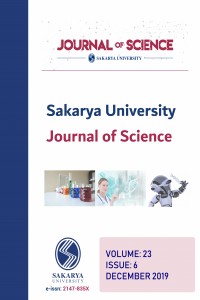Abstract
References
- [1] R. T. Leon, J. J. Hoffman, and T. Staeger, Partially restrained composite connections: a design guide. American Institute of Steel Construction, 1996.
- [2] ‘Eurocode 4: Design of composite steel and concrete structures - Part 1-1: General rules and rules for buildings Eurocode’, 2004.
- [3] R. T. Leon, ‘Composite connections’, Prog. Struct. Eng. Mater., vol. 1, no. 2, pp. 159–169, 1998.
- [4] R. T. Leon, Composite connections. 1999.
- [5] A. Reyes-Salazar, J. M. Sauceda-Pimentel, S. E. Ruiz, E. Bojórquez, and J. Bojorquez, Seismic response and energy dissipation of 3D complex steel buildings considering the influence of interior semi-rigid connections: low- medium- and high-rise, no. 0123456789. Springer Netherlands, 2018.
- [6] W. Zhang, ‘Study of the Influence of Gravity Connections on the Lateral Response of Steel-Concrete Composite Moment Frames’. University of Cincinnati, 2012.
- [7] B. Akbaş and J. Shen, ‘Seismic behavior of steel buildings with combined rigid and semi-rigid frames’, Turkish J. Eng. Environ. Sci., vol. 27, no. 4, pp. 253–264, 2003.
- [8] B. F. Maison, C. O. Rex, S. D. Lindsey, and K. Kasai, ‘Performance of PR Moment Frame Buildings in UBC Seismic Zones 3 and 4’, J. Struct. Eng., vol. 126, no. 1, pp. 108–116, 2000.
- [9] Afet ve Acil Durum Yönetimi Başkanlığı, Türkiye Bina Deprem Yönetmeliği. Ankara, 2018.
- [10] ASCE/SEI, ASCE 41-13 : American Society of Civil Engineers : seismic evaluation and retrofit of existing buildings. 2013.
- [11] A. Astaneh-asl, Design of Shear Tab Connections for Gravity and Seismic Loads, no. June. 2005.
- [12] A. E. Maleck, ‘Second-Order Inelastic and Modified Elastic Analysis and Design Evaluation of Planar Steel Frames’, no. April, 2001.
- [13] Sap2000 C.S.I, ‘Computers and structures Inc’, Berkeley, CA, USA, 2005.
A Numerical Investigation of the Influence of Semi-Rigid Composite Connections on the Seismic Behavior of a Building with Steel Concentrically Braced Frames
Abstract
Semi-rigid composite connections are connections which have a certain rotational stiffness and bending strength by means of the slab and its reinforcement. The use of these connections can lead to economic and structurally efficient solutions such as selecting smaller beam sections, reducing deflection and vibration problems. Additionally, they are permitted to use as a secondary lateral resisting system in regions of high seismicity. Therefore, in this study, two investigations were made in terms of seismic behavior evaluation: the influence of semi-rigid composite beam-column connections on interior frames and the influence of shear tab connections. Firstly, a 6-story building with steel special concentrically braced frames is designed according to current seismic design codes. Secondly, 3 models are created using the designed building. In Model 1, all beam-column shear tab connections are assumed as pinned connections. Model 2 and Model 1 are identical except that In Model 2, shear tab connections used in Model 1 are not assumed as pinned connections and their actual behavior is determined and included to the model. In Model 3, all beam-column connections on the interior frames are designed as semi-rigid composite connections. The interior frame sections are reselected and the exterior beam-column connections except for the ones on the braced bays are assumed the same as in Model 2. Lastly, nonlinear static analysis (pushover) is carried out and some comparisons are made with respect to the following aspects: lateral displacement and story drifts under same lateral force and lateral force under the same lateral displacement. As a result, Model 1 and Model 2 showed similar behavior due to the shear tab connections acting almost as pinned while Model 3 showed that using semi-rigid composite connections can increase the base shear capacity by %48 and decrease peak displacements and story drifts by %65.
Keywords
semi-rigid composite connections concentrically braced frames nonlinear static analysis pushover
References
- [1] R. T. Leon, J. J. Hoffman, and T. Staeger, Partially restrained composite connections: a design guide. American Institute of Steel Construction, 1996.
- [2] ‘Eurocode 4: Design of composite steel and concrete structures - Part 1-1: General rules and rules for buildings Eurocode’, 2004.
- [3] R. T. Leon, ‘Composite connections’, Prog. Struct. Eng. Mater., vol. 1, no. 2, pp. 159–169, 1998.
- [4] R. T. Leon, Composite connections. 1999.
- [5] A. Reyes-Salazar, J. M. Sauceda-Pimentel, S. E. Ruiz, E. Bojórquez, and J. Bojorquez, Seismic response and energy dissipation of 3D complex steel buildings considering the influence of interior semi-rigid connections: low- medium- and high-rise, no. 0123456789. Springer Netherlands, 2018.
- [6] W. Zhang, ‘Study of the Influence of Gravity Connections on the Lateral Response of Steel-Concrete Composite Moment Frames’. University of Cincinnati, 2012.
- [7] B. Akbaş and J. Shen, ‘Seismic behavior of steel buildings with combined rigid and semi-rigid frames’, Turkish J. Eng. Environ. Sci., vol. 27, no. 4, pp. 253–264, 2003.
- [8] B. F. Maison, C. O. Rex, S. D. Lindsey, and K. Kasai, ‘Performance of PR Moment Frame Buildings in UBC Seismic Zones 3 and 4’, J. Struct. Eng., vol. 126, no. 1, pp. 108–116, 2000.
- [9] Afet ve Acil Durum Yönetimi Başkanlığı, Türkiye Bina Deprem Yönetmeliği. Ankara, 2018.
- [10] ASCE/SEI, ASCE 41-13 : American Society of Civil Engineers : seismic evaluation and retrofit of existing buildings. 2013.
- [11] A. Astaneh-asl, Design of Shear Tab Connections for Gravity and Seismic Loads, no. June. 2005.
- [12] A. E. Maleck, ‘Second-Order Inelastic and Modified Elastic Analysis and Design Evaluation of Planar Steel Frames’, no. April, 2001.
- [13] Sap2000 C.S.I, ‘Computers and structures Inc’, Berkeley, CA, USA, 2005.
Details
| Primary Language | English |
|---|---|
| Subjects | Civil Engineering |
| Journal Section | Research Articles |
| Authors | |
| Publication Date | December 1, 2019 |
| Submission Date | January 10, 2019 |
| Acceptance Date | September 9, 2019 |
| Published in Issue | Year 2019 Volume: 23 Issue: 6 |
Cite
INDEXING & ABSTRACTING & ARCHIVING
Bu eser Creative Commons Atıf-Ticari Olmayan 4.0 Uluslararası Lisans kapsamında lisanslanmıştır .


